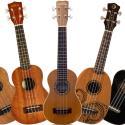
More Ukulele Guides
Unlike some other instruments, ukulele sizes aren’t named like separate instruments (violin vs. viola, and mandolin vs. mandola). This has led to confusion, and because the different body types sound and feel different to play many musicians aren’t sure which body style will be right for them – this guide will help you understand what each shape and size is.
Note that there are small variations between different brands and models, and as a result the measurements provided below are approximate.
Soprano Ukulele
A soprano ukulele is the smallest commonly found ukulele. The soprano size has that trademark plinky ukulele sound, though because it doesn’t have a very large resonating surface it doesn’t have the volume or depth of tone you’d find in a larger instrument.
The traditional tuning of the soprano ukulele is A4, D4, F#4, and B4, though most musicians tune them down one whole step G4, C4, E4, A4.
Overall Length: 21 inches
Pineapple Ukulele
Pineapple ukuleles (which as you might have guessed are shaped like a pineapple) have a similar response to that of a soprano ukulele but offer a more harmonically rich tone because of their larger resonating surface.
Overall Length: 21 inches
Concert Ukulele
The concert ukulele is the middle ground between a tenor and soprano ukulele. It has the delicate and sweet tone of a soprano ukulele while having some of the depth of a tenor. Concert ukuleles are tuned the same as sopranos.
Overall Length: 23-25 inches
Tenor Ukulele
Tenor ukes are becoming more and more popular due to their versatility. They’re more appealing to finger-pickers due to their longer scale length (see the section below for a definition of scale length). Tenor ukuleles can be tuned to either high-G (the same as a soprano or concert) or low-G. Low-G tuning offers more possibilities, though it’s not as traditional sounding as high-G tuning.
Overall Length: 26-27 inches
Here’s an example of the difference between high and low-G:
Baritone Ukulele
The baritone ukulele is unique in that it doesn’t use a reentrant tuning. What this means is that the strings are ordered from those lowest in pitch to those highest, as opposed to other ukuleles which are not.
This body style, while retaining some of the sound the ukulele is known for, has a response similar to that of a classical guitar. This means that it wouldn’t be the best fit for someone looking for a traditional ukulele tone, but at the same time it does have a pretty unique sound.
The baritone ukulele is also tuned a fourth lower than other body styles, so playing music intended for tenor-style or smaller ukuleles will require some transposing.
Overall Length: 30-31 inches
Other Ukulele Types
Manufacturers are free to design their ukuleles however they see fit. So in addition to these main types, expect hybrids, and unique types like the bass ukulele which handles lower frequencies much like a regular bass guitar.
Scale Length
Scale length is the distance between the nut and the neck. It impacts both the tone of the strings and the force required to play them. The longer the scale length the more the top resonates (which increases volume), though a longer scale length can somewhat reduce warmth.
Overall Length
Note that a ukulele’s overall length is longer than the scale length – a rough rule of thumb is that the overall length will be about 1.5 to 1.6 times longer than the scale length for most ukuleles.
Questions?
If you have any questions about the different sizes of ukuleles then post them below for further help.






My ukulele has a head to fret length of 21” and full body is 24”, what kind is it? I need to buy the right case… thank you!!
What you have is called a concert ukulele
I build banjo ukuleles. I build tenors with a 17” scale (8” rim) and baritones with a 19” scale and an 11” rim.
Need recommendations on strings. I’ve been using Aquila AQ-42 on the tenors (tuned to C, high 4th) and AQ -21 on the baritones (tunes to G, low 4th). I like the all nylon rather than metal wound. What do you think – are there better choices?
I went to a local music store. I want a ukulele that is similar to guitar chords so I can convert to guitar later. They sold me what they said is a baritone Krime Uku it is 30” long.
Is this a baritone? Does it relate to guitar chords? Your site says baritones are 19”-20”. Please help
Stephanie
Hi Stephanie,
Stringed instruments such as Ukuleles and Guitars have two separate lengths that are used to measure different things.
Scale length essentially measures the vibrating length of the strings which is an indicator of string tension.
Overall length of the instrument tells you how long a box or case needs to be to hold it.
30″ is a correct overall length for a baritone ukulele which will typically also have a scale length of 19-20″.
Based on what you said the store has given you a baritone ukulele which has 4 strings tuned to the same D G B E of the 4 highest pitched guitar strings in standard tuning.
So it sounds like the store has given you exactly what you wanted which will make it easier to start playing guitar later.
Jason.
PS: I’ve changed the article above to reduce confusion over the two lengths.
Hello! Can I please use your ukulele size comparison chart for a college project I’m working on, please?
Thank you very much!
Please use our contact form to submit requests like these.
What is the volume of a soprano ukulele body?
I’m new to this I really want a ukulele, i know i want the larger one, i want to learn with good sound,
Does anyone play country with these, country rock .
Thank you for any info that may help me .
I was told my ukulele was a concert size but when I ordered a case it was much too short. Can you tell me how many inches a tenor is from top to bottom?
My Tenor with 17″ scale is 26″ total.
I’m a beginner and I already have a Makala concert uku, but I would like to get a new uku that’s not a concert. Which uku size should I get?
That all depends on the type of sound you want.
If you want that classic ‘plinky’ sound then get a Soprano Ukulele, otherwise you could try a Tenor Ukulele which gives you the option of trying new types of tuning as well as sticking to what you’re used to.